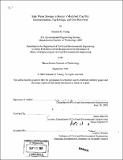Safe water storage in Kenya's modified clay pot : standardization, tap design, and cost recovery
Author(s)
Young, Suzanne E
DownloadFull printable version (14.20Mb)
Other Contributors
Massachusetts Institute of Technology. Dept. of Civil and Environmental Engineering.
Advisor
Susan Murcott.
Terms of use
Metadata
Show full item recordAbstract
One of the main components necessary for providing safe drinking water for users who lack piped water in the home is the ability to safely store it in the home. Users in the Nyanza Province of Kenya frequently carry water from some distance or purchase vended water and traditionally store this water in their homes in clay pots. CARE/Kenya, a non-governmental organization working in conjunction with local women potters and the Centers for Disease Control and Prevention, modified these clay pots so that they fit the definition of designated safe storage water containers, which contain the following three characteristics: a narrow mouth, a lid, and a tap to prevent recontamination. Three pottery production sites were visited in order to document, analyze, and suggest improvements for the design of the modified clay pots, specifically with regards to the standardization of the size and shape of the pots, so as to allow simple and convenient standardized household chlorine dosing, and the tap design and attachment, because the current tap design is expensive and prone to leaking. (cont.) The modified clay pots displayed little variability in pot dimensions, and the 20 liter modified clay pots from the Amilo location showed a less than or equal to 10% volume variability that is acceptable according to the Centers for Disease Control and Prevention household chlorine dosing procedure. A reference rope tool developed to help standardize the size of modified clay pots can be used to train new potters but is not necessary for experienced potters. The spring-operated plastic tap was found to be the most promising design to replace the current metal tap design. The material cost of the modified clay pots at the three sites was determined with some certainty to range from 202-370 KSH (US$2.70-US$4.90). However, labor costs, transportation costs, profit margins and the role of subsidies, if they exist, were unable to be accurately determined. Therefore, cost recovery of the modified clay pot is unclear at all three pottery sites due to insufficient data.
Description
Thesis (M. Eng.)--Massachusetts Institute of Technology, Dept. of Civil and Environmental Engineering, 2005. Includes bibliographical references (leaves 117-120).
Date issued
2005Department
Massachusetts Institute of Technology. Department of Civil and Environmental EngineeringPublisher
Massachusetts Institute of Technology
Keywords
Civil and Environmental Engineering.